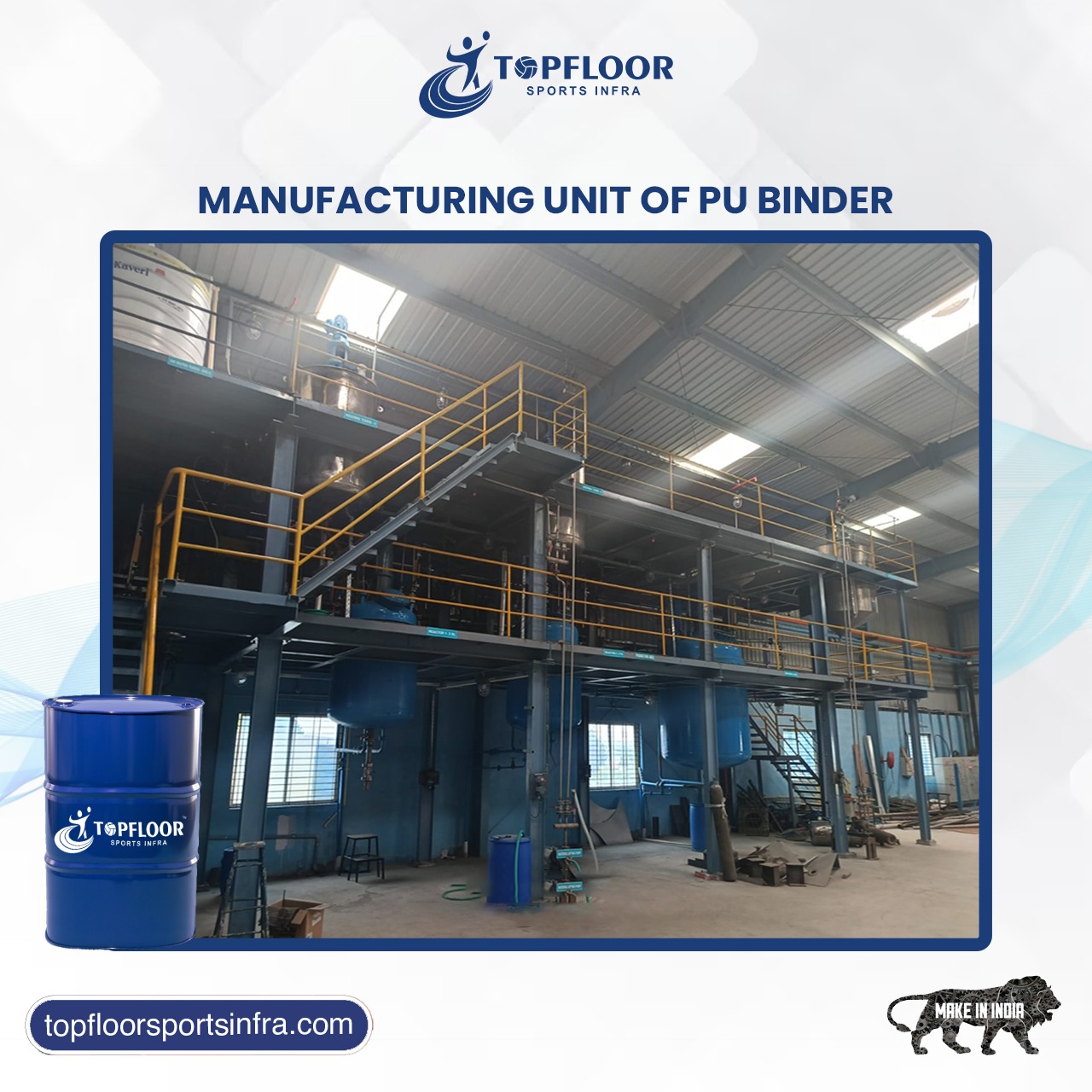PU Binder
Since its invention, polyurethane has been one of the most important compounds, with numerous applications. A leading participant in coating and printing applications, polyurethane is known for its flexibility, strong chemical structure, and user-friendly qualities. Topfloors Sports Infra is a PU Binder manufacturer in India, and our one-component, moisture-curing, unpigmented PU binders are DESMOTOP-RR 2009 and DESMOTOP-RR 2008. Timber, polystyrene foam, plastic, urethane foam, reclaimed rubber, gravel, cloth, metal surfaces, and many more substrates can be bonded with these. Substrate, ambient temperature, and relative humidity determine the PU binder cure rate. Using a hot press on PU binder can drastically shorten the curing period.



| Property | Unit | DESMOTOP-RR 2009 | DESMOTOP-RR 2008 |
| Appearance | Yellowish liquid | Clear liquid | |
| NCO content | % | 10 ± 0.3 | 11 ± 0.5 |
| Solid content | % | > 99 | 100 |
| Density at 25°C | % | 10 ± 0.3 | 11 ± 0.5 |
| NCO content | g/cm3 | 1.08 ± 0.05 | 1.09 ± 0.03 |
| Viscosity at 25°C | cps | 2200 ± 500 | 2400 ± 500 |
| Flash point | oC | > 200 | > 200 |
| Tack free time at 25°C/50% rel. hum. | hr | 4-6 | 4-6 |
| Download TDS | Download TDS |
- Simple to transport and put away
- Quite simple to handle
- Strongest possible connection
- Immaculate transparency
- Single Component
- No solvent is needed
- Very thin film
- Increased Durability
- Floors for Kids’ Play Areas
- Sports Fields
- Pavers and garden design
- Rubber goods through molding
- DESMOTOP-RR 2009: 200 kg Drum/ 25 Kg Drum
- DESMOTOP-RR 2008: 200 Kg Drum / 25 Kg Drum
- DESMOTOP-RR 2009: Rubber Tiles, Plastic, Crumb Rubber, Polyurethene Reboand
Foam Binder - DESMOTOP-RR 2008: EPDM Rubber Granules, SBR Granules.
PU Binder – FAQs
-
What is a PU rubber binder made of?
One form of adhesive or bonding agent made with polyurethane resins is a PU binder for rubber. Rubber mats, playground floors, and athletic tracks are just a few examples of the many goods that bind rubber particles together.
-
What are the benefits of using PU binder in rubber goods?
Rubber goods are made better in terms of strength, flexibility, and longevity when PU binders are used. They make the rubber particles stick together well, making the substance strong and durable. As a result, rubber-based treatments work better and last longer.
-
To what extent do PU binders improve rubber products?
When compared to other binding materials, PU binders are far superior in terms of bonding strength, durability, flexibility, and resistance to weather. Their versatility stems from the fact that they help rubber products remain stable and long-lasting in general.
-
Is it possible to use PU binders outside?
Certainly, PU binders can withstand the elements. Outdoor rubber products, such as playgrounds, sports surfaces, and running tracks, benefit greatly from their high resistance to weathering, temperature fluctuations, and ultraviolet radiation.
-
How is a polyurethane binder mixed with rubber?
One common method of applying PU binders is to combine them with rubber particles. The resulting slurry is then either poured or smeared onto a surface. After the binder cures, the mixture is balanced, and the result is a rubberized substance that is both strong and flexible.
-
Is it possible to recycle rubber using PU binders?
When it comes to recycling rubber, PU binders are an important component. One way they can help with sustainability and trash reduction is by binding recycled rubber particles together to make new products.
-
When applied, how does a PU binder typically cure?
The amount of time it takes for PU binders to cure is condition- and product-dependent. For the binder to completely cure and the rubber product to attain its intended qualities, it usually takes a few hours to a day.
-
Are EPDM-colored granules compatible with PU binder?
Children’s play areas, walking paths, and jogging paths are made with PU binder mixed with EPDM-colored granules.
-
When would you use a PU binder?
When making rubber goods, adhesives called polyurethane (PU) binders are utilized. They form a strong link between the rubber granules, making the surface resistant to wear and tear. Its sports surface applications are many.
Completed Project Gallery

Our App is live Now!
Visualize and Explore Sports Courts with Ease
Topfloor Sports Infra Pvt Ltd. introduces a powerful tool to explore and visualize various sports courts and flooring layouts. This app is designed for professionals and enthusiasts involved in sports infrastructure who want to see how different surfaces look in real time.




